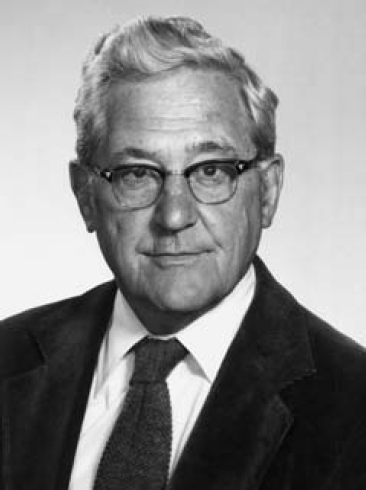
1913–2008
Elected in 1979
“For contributions to the theory and applications of compact heat exchangers, especially in the gas turbine field.”
BY SALOMON LEVY
ALEX LOUIS (“LOU”) LONDON was one of the world’s best-known experts in heat transfer equipment design, performance, and analysis. He died on March 19, 2008, following a short illness after a stroke.
He was born on August 31, 1913, in Nairobi, British East Africa (now Kenya). In 1921 his parents moved to the United States, which allowed Lou London to attend school in Oakland, California, and to get a bachelor of science (B.S.) in 1935 and a master of science (M.S.) in 1938 in mechanical engineering from the University of California at Berkeley. During the period 1935 to 1938, he was employed by Standard Oil of California, he was an instructor at the University of Santa Clara, and he met and married his wife Charlotte. They had three children, and they were together for 61 years until her death in 1999. Since 2000 he lived in San Rafael with his son Allan.
Lou London began his career at Stanford University in 1938, where he was a professor of mechanical engineering until 1971. He continued to supervise graduate students until 1988, and he wrote 52 published technical papers with them. During World War II, he was in the U.S. Navy on active duty for three years doing research for the Bureau of Ships. He retired with the rank of commander from the Naval Reserve in 1978. In 1964 he worked for General Motors on gas turbines, and in 1979 he helped formulate Stanford’s geothermal program.
Professor London was an authority on compact heat exchangers. Typically, they are devices that remove unwanted heat from engines and disperse it into the air. The most common compact heat exchangers are the radiators in automobiles, but they are also used in airplane engines, refrigerators, computers, and gas turbines to produce electricity.
Professor London was the first to organize the field of compact heat exchangers. He was helped by Bill Kays, a former student who eventually became dean of engineering at Stanford University. Together, they wrote the book Compact Heat Exchangers (Academic Press, 1978), which became a prominent reference used all around the world. It utilizes the concept of Number of Transfer Units (NTUs) to simplify the determination of heat exchanger effectiveness and covers a multitude of configurations and extended surfaces. Professor London wrote another book with R. K. Shak, Laminar Flow Forced Convection in Ducts.
Professor London was a member of the American Society of Mechanical Engineers (ASME), a member of Sigma Xi, a life member of the American Society for Engineering Education, a member of the American Society of Naval Engineers, and a member of the American Association of University Professors. That large number of memberships speaks for his diversity of interests.
Professor London was a real, practical teacher. He took his students on field trips to power plants, electrical switching stations, oil platforms, and such applications as aircraft engines. He was tough, and he did not hesitate to mark student papers with NONSENSE in red ink. At technical meetings he would get up and tell the speaker that he was violating the fundamental laws of thermodynamics: The “secret” he transmitted to his students was that they needed to take the system they were studying and “put it in a box,” better known as control volume. Then they should apply the basic principles of physics to that control volume and learn whatever they needed to know about the system. Professor London was a craftsman as he demonstrated his analysis methods on energy
transfer devices, showing that believing and applying such principles as the second law of thermodynamics can spare an engineer much frustration.
Professor London was awarded the ASME Heat Transfer Memorial Award in 1952, the ASME Gas Turbine Division Best Paper Award in 1964, its R. Tom Sawyer Award in 1977, and its James Harry Potter Award Gold Medal in 1980. He received the Max Jakob Memorial Award in 1984. He was inducted into the National Academy of Engineering in 1979 and into the Silicon Valley Engineering Hall of Fame in 1990. His outstanding contributions to education, research, and professional services have not gone unnoticed.




